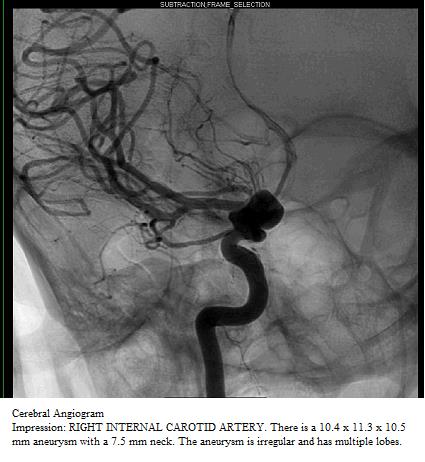Case Presentation: A 28 year-old woman with AIDS and a CD4 count of 178 cells/mm3, not on antiretroviral therapy, presented with odynophagia for 2 weeks as well as increased swelling in her neck and inguinal area. She denied any neurological symptoms. On physical examination, the patient had extensive cervical lymphadenopathy with no other significant findings. EGD revealed esophageal candidiasis and HSV esophagitis. Fluconazole, acyclovir, dolutegravir, and emtricitabine/tenofovir were started. CT neck with contrast to evaluate the lymphadenopathy incidentally showed an enlargement of the right internal carotid artery with suspicion for aneurysm. MRA confirmed a 17 mm x 19 mm x 19 mm right supraclinoid internal carotid artery aneurysm extending to the origin of the right ophthalmic artery. The sizable intracranial aneurysm prompted immediate angiography that revealed a right ophthalmic and left anterior cerebral artery aneurysm. She was transferred to the neurosurgical service with plans to place a pipeline stent in the right ophthalmic aneurysm. The procedure was postponed due to MRSA bacteremia and the patient was lost to follow-up after discharge.
Discussion: Patients with HIV/AIDS often have a myriad of complications affecting many organ systems. Thirty to forty percent of adults with AIDS have a neurological complication in their lifetime, neoplasm and infection being the most common. A recent cohort study found the prevalence of cerebral aneurysms in HIV patients to be 13.9 % compared with 2% in the general population.[1] The exact pathogenesis of cerebral aneurysm formation in patients with HIV is unclear. Current hypotheses include non-HIV viral vasculitis, direct HIV invasion of endothelial cells, and molecular mimicry resulting in an autoimmune response. There are currently no screening or treatment guidelines on HIV-associated carotid aneurysms, but they are often treated surgically or through endovascular repair.
Conclusions: Cerebral aneurysms may occur in patients with AIDS and most are asymptomatic before they rupture. Further research on the appropriate screening and management of this complication in patients with AIDS is warranted.

